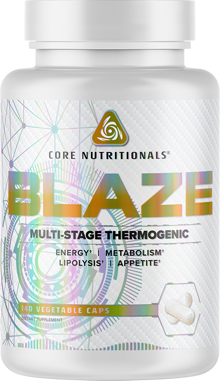Articles on Core Nutritionals Blaze:
-
Jun 22, 2021 
Core BLAZE: Appetite-Attacking Fat Burner
Core Nutritionals BLAZE is a fat burner that targets several metabolic pathways and uses several unique ingredients. Tired of fat burners? Try this!
Multi-Stage Thermogenic
- Caulerpa okamurae - can inhibit lipid accumulation and enhance adipogenesis.
- Glucovantage - highly bioavailable form of berberine and can help maintain healthy glucose and lipid levels while supporting vascular health.
- Advantra Z - potent form of synephrine known for its ability in increasing thermogenesis.
split
Everywhere you look, there is a new story about a magical fat burning formula with substances that will make every other ingredient before it obsolete. Some of these claims may have merit, but the truth is that the biochemical processes of lipolysis are very complex and tightly regulated by the endocrine system and other biochemical pathways. Navigating this maze to effectively manage weight and body composition therefore requires more than a single, “magical” compound: it involves numerous agents that work synergistically to achieve certain metabolic functions, while suppressing others. No single ingredient does the job alone.
Core BLAZE is formulated to drop the kitchen sink and “miracle” ingredient tactics, and instead uses a diverse range of scientifically proven ingredients to create a powerful, balanced, and effective product. Core BLAZE is designed to target precise primary and secondary metabolic pathways, at multiple targets, to ensure maximum effectiveness. No more playing darts in the dark when it comes to weight management categories; randomly including ingredients, in whatever servings, hoping that something works. Specific and multi-targeted. These words exemplify the new, must needed approach. Amazing ingredients, in clinically-reflected serving sizes, all included in a non-proprietary blend so you know exactly what you’re consuming to incinerate fat stores and reach your body composition goals.
split
Black Cumin Seed Powder
Black cumin, also known as Nigella sativa, is a plant that has been touted for its medicinal benefits that target relief from abdominal pain, dyslipidemia, asthma, headache, inflammation, obesity, and hypertension, amongst other things. In relation to some of these clinical conditions, in particular dyslipidemia and obesity, a wide variety of plants have been reported for their lipid lowering benefits. Nigella sativa has particularly been studied for these benefits on animals. While a primary mechanism of action has to be discovered for Nigella sativa, it is believed that its anti-obesity benefits are as a result of its effects on the gene expression of inflammatory and adipogenesis-related factors, including TNF-α, PPAR-γ, and adiponectin. One study in particular using Nigella sativa as a complementary factor in obesity management, along with proper diet and exercise, was shown to reduce body weight and BMI. Waist circumference was not statistically significant but more research is needed to look at other anthropometric benefits.
Acetyl L-Carnitine
L-carnitine is a derivative of the amino acid lysine and, as certain conditions outpace the body’s ability to produce it, l-carnitine is considered a conditionally essential amino acid. While endogenous biosynthesis of l-carnitine from the amino acids lysine and methionine is sufficient for essential processes – along with dietary sources of carnitine from protein-rich red meat, for example – dietary supplementation of carnitine may pose benefits in certain physiological conditions.
Unfortunately, due to excess metabolism of l-carnitine by microorganisms in the small intestine, exogenous supplementation with oral l-carnitine has proved ineffective. ALCAR, an acetylated version of l-carnitine, has considerably higher oral bioavailability, due likely to only partial hydrolytic metabolism. Once in the bloodstream, ALCAR plays a fundamental role in the production of energy, acting as the catalyst for the beta-oxidation of long chain fatty acids by the mitochondria; regulating the CoA to Acyl-CoA ratio (necessary for the production of ATP); and the metabolism of carbohydrates. ALCAR also is an excitatory agent for neurons, increases neuronal transmission, and increases the production of neurotransmitters and neurohormones such as dopamine and serotonin.
Schisandra Extract (9% Schisandrins)
Schisandra chinesis is a plant that has been studied to have beneficial health effects. Among these benefits include anti-cancer effects as well as antimicrobial effects against pathogens. In relation to metabolic benefits, studies have shown diets rich in Schisandra can improve pancreatic functions, stimulate insulin secretion, and reduce diabetic complications. Where Schisandra’s body composition benefits lie is in its proposed ability to prevent lipid accumulation and differentiation of preadipocytes to adipocytes. This process, known as adipogenesis is characterized by the ability of adipocytes to accumulating triglycerides in cytosolic lipid droplets, which are reservoirs for energy storage. Schisandrin has shown its ability to reduce lipid content, as well as increase acid oxidation and lipolysis. This process was shown to occur through the activation of protein kinase A and hormone sensitive lipase in the adipocytes of rats. In vivo, Schisandrin was shown to reduce subcutaneous adipocyte size, tissue mass, as well as body weight in mice.
The major regulator of this adipogenesis is peroxisome proliferator-activated receptor gamma (PPAR-γ). This specific receptor activates genes that stimulate lipid uptake and the generation of new adipocytes. Insulin sensitizers act as agonizer, which are able to increase triglyceride storage in adipose tissue by increasing insulin-stimulated glucose uptake. Schisandrin and its specific lignans were shown to prevent lipid accumulation and the differentiation of adipocytes through the mechanism of downregulating the key adipocyte regulatory genes PPAR-γ and others associated with such. These results are promising as a possible intervention in combatting weight gain.
Caulerpa Okamurae (50% Sodium Alginate)
Seaweeds and other marine algae are a broad species that have often been considered a potential source for combating obesity and aiding in weight loss. Seaweeds in particular possess certain bioactive compounds that have the fat fighting agents with high potential. Fucoxanthin, alginates, fucoidans, and phlorotannins are these specific compounds. These compounds exhibit a mechanism of action that include the inhibition of lipid absorption and metabolism (fucoxanthin and fucoidans), the inhibition of adipocyte differentiation (fucoxanthin), and the effect on feelings of satiety (alginates). Caulerpa okamurae is a specific seaweed, and in this case for Core BLAZE, we wanted to include a source that included 50% sodium alginates, which we just learned that alginates especially contribute to feelings of fullness. Caulerpa okamurae has been shown in studies to reduce obesity-mediated inflammation, improve glucose metabolism, and increase insulin sensitivity. Studies have also shown Caulerpa okamurae to have the ability to inhibit lipid accumulation and reduce the expression of the master regulator of adipogenesis. One study in particular done on high fat fed mice showed that with the administration of Caulerpa okamurae, markers of weight gain such as free fatty acids, triglycerides, total cholesterol, glucose, and plasma insulin were reduced significantly.
Caffeine Anhydrous
Caffeine is one of the most widely consumed, and perhaps one of the most reviewed, psychoactive compounds. Its physiological effects in a range of areas have been well-documented, including exercise performance, information processing, alertness and mood enhancement, attention, and awareness, along with its anti-lipogenic and lipolytic abilities.
Most importantly to Core BLAZE, caffeine has been shown to have significant effects on exercise performance, even with ingestion in servings as small 3 to 9mg/kg/bw/day (the equivalent of 2 cups of standard coffee, for a 170lb male). In endurance training, possible explanations for caffeine’s performance-enhancing effects lie in its metabolic effects on both lean and fat tissue. It is suggested that caffeine’s potent lipolytic (the breakdown of fat tissue into fatty acids) and oxidative (the actual ‘burning’ of fat) action allow the body to utilize these sources during prolonged submaximal exercise. As a consequence, muscle glycogen is spared and available for use later in the training session. Practically speaking, this means caffeine is forcing your body to preferentially use fat tissue as a fuel source, while sparing the glycogen which gives you the full-bodied look!
In short-term exercise, caffeine’s demonstrated role in the inhibition of cyclic AMP- phosphodiesterases (PDE), adenosine receptor antagonism, and adrenoreceptor agonism come into play. These three pathways collectively stimulate lipolytic activity, boost fat metabolism, increase metabolic rate and energy expenditure, and regulate the body’s thermogenic activity. The practical results of activating these pathways are increases to the contractile force of both cardiac and skeletal muscle (harder flexion), an increase in energy expenditure (freeing up more caloric energy to be used in contraction), dilation of vasculature (better blood flow), and improvements to both nitrogen retention and skeletal muscle protein synthesis (key components to muscle building).
In Core BLAZE, we have included a per-serving amount of caffeine that is neither excessive, nor arbitrary, but that instead reflects the servings used in clinical research.
Bacopa monniera (50% Bacopasides)
Bacopa monnieri (BM), also known as the water hyssop commonly, or as Brahmi in Ayurvedic texts, is a small creeping herb endemic to sub-tropical India. The herb has been used in traditional Indian medicine for well over one thousand years, with its first recorded usage coming in the 6th century A.D. In this traditional context, BM has been used for a wide-range of purposes, including as a treatment of asthma and epilepsy.
More recently, BM has been the subject of numerous cognition and memory trials, as the plant has a well-established nootropic effect. Likely through modulation of the serotonin reuptake system, clinical trials in healthy human beings have demonstrated that BM possesses a significant effect on the retention of newly-learned information. In several trials utilizing a 300mg daily serving, BM was also shown to decrease the recall delay of newly learned information and reduce short term forgetfulness – suggesting that the herb’s effect on the serotonic and cholinergic systems are increasing the encoding (the literal storing) of memory information.
Beyond cognition and memory encoding, BM has also been demonstrated to function as a potent adaptogen and relaxant – which in the Core BLAZE formula may help to smooth the effect curve of the product’s stimulants, reducing jitteriness or “crash.”
Theobromine
Theobromine, one of the main methylxanthine compounds found in cocoa is primarily effective in the increase of nitric oxide to in the blood stream, which is beneficial to produce the “pump” when ingested pre-workout. Another reaction that can be seen with theobromine is dilation of blood vessels. This can increase blood flow during vigorous exercise leading to increased time to exhaustion but also can pose benefits to individuals who suffer from high blood pressure. Theobromine also has a very high bioavailability and ability to stay in the body for extended periods of time (7-8 hours). Several studies have also looked at the effects of theobromine on human subjects and results have shown its ability to reduce oxidative stress on cells and regulation of gene expression.
Glucovantage
Glucovantage is a sustained release dihydroberberine, which is a highly bioavailable derivative of berberine. Once absorbed in the intestines, dihydroberberine rapidly converts to berberine in the blood and has been shown to be up to 5x more bioavailable than standard berberine. The benefits of berberine have been extensively studied for its positive effects on glucose balance, lipid metabolism, and overall blood vessel health. In fact, berberine is one of the leading compounds that is used to increase insulin sensitivity, or how well your body responds to insulin. Glucose uptake to tissues is influenced by berberines ability to activate the adenosine monophosphate kinase (AMPK) pathway, which plays an important role in energy balance regulation. Results from pre-clinical studies indicate berberine promotes healthy cholesterol metabolism by a variety of actions. It has the ability to upregulate LDL-receptors on liver cells that shuttle cholesterol out of the blood and into the necessary cells. Berberine inhibits intestinal cholesterol absorption and increases excretion as well as provides antioxidant defense. By activating AMPK, for the purposes of glucose balance, it also increases fatty acid oxidation (burning) and decreases fatty acid synthesis. As a highly bioavailable form of berberine, Glucovantage dihydroberberine may help maintain healthy blood glucose and lipid levels in the normal range while supporting vascular health.
Advantra-Z (Citrus Aurantium)
Synephrine is a naturally-occurring alkaloid with adrenergic agonist activity, structurally related to epinephrine, norepinephrine, ephedrine, and other compounds with a phenethylamine base structure. Despite its chemical similarity to these compounds, synephrine in its various isomers exerts unique effects on adrenergic receptors, in particular, and the human body, in general.
Synephrine exists in three isomer forms: para-, meta- and ortho-synephrine. The molecular changes between the three isoforms are minute, but even this small change results in significant alterations to each isomer’s physiological and pharmacokinetic profile. Two of synephrine’s isomers, both p- and m-synephrine, have been shown to naturally occur in mammals (in low concentrations). As a sympathomimetic, synephrine has been the subject of numerous trials, assessing its effects on weight management, thermogenesis, metabolic rate, and caloric expenditure. In a double-blind, randomized, and placebo-controlled trial involving 10 healthy individuals, the p-synephrine isomer was administered at a 50mg serving, both alone, and in combination with hesperidin and naringin. The authors measured resting metabolic rate (RMR), blood pressure, and heart rate, along with subjective feelings of mood and energy, at baseline, and at 45-mintues and 75-minutes after ingestion. The authors reported a significant increase in RMR in each of the supplement groups, relative to placebo.
In addition to studies on synephrine in its various isomers, Advantra-Z, the specific form of synephrine utilized in Core BLAZE, has itself and in combination with other ingredients, been the subject of various clinical trials in humans. In a randomized, double-blind, placebo-controlled trial featuring 70 obese adults, a formulation containing Advantra-Z was found to significantly reduce fat mass, body weight, and hip and waist girth as compared to controls, while leading to an increase in lean mass. As the authors comment, these results are in-line with a recent systematic review of human clinical studies involving Citrus aurantium, that revealed the ingredient to reliably increase resting metabolic rate up to 7.2%, increase energy expenditure of up to 13.4%, and weight loss of over 2.9 kg, with no serious adverse events in any of the trials.
In addition, the combination of caffeine and synephrine appears to potentiate each ingredient’s effects – with rates of fatty acid liberation, heart rate, metabolic rate, and fatty acid oxidation increased in clinical trials featuring the combination. In the same systematic review mentioned above, the authors note that the combination of synephrine and caffeine led to a small but significant reduction in fat mass of 3lbs, and a reduction in bodyfat of 2.9%.
Combined with not only caffeine, but the other ingredients in Core BLAZE, Advantra-Z appears to be a potent weapon in the arsenal for body composition and weight management.
Capsimax
Many people have eaten red chili peppers. But did you know that these peppers have an effective benefit when it comes to boosting metabolism and aiding in weight management? These compounds, known as capsaicinoids, are responsible for the “burnin” or hot sensation experienced when consuming spicy food. Capsimax is a concentrated extract of these capsaicinoids from these peppers in a safe and easy on the stomach form, so you can reap the benefits without the negative stomach discomfort commonly associated with capsaicin.
The capsaicinoids found in Capsimax are absorbed through the gastrointestinal tract and then dispersed throughout the body. Their ability to influence weight management and energy metabolism are governed by specific activation processes. Activation of sarcoplasmic reticulum Ca+ ATP-ase (SERCA) and Uncoupling Protein (UCP1) convert working energy in ATP into heat energy. This process is known as thermogenesis. Transient receptor potential cation channel subtype 1 (TRVP1) are found in the sensory tissue as well as GI, liver, and adipose tissues. The activation of TRVP1 has the potential to reduce visceral adipose tissue by increasing lipolysis, fat oxidation, and reducing appetite.
Yohimbine HCL
Extracts or preparation of Pausinystalia yohimbe, and related sub-species, have been used in traditional and folk medicinal systems such as Ayurveda and Unani for centuries. More recently, the principal bioactive compound in Pausinystalia yohimbe, both as a whole plant, and its extracted components, has been the subject of numerous clinical trials investigating its various physiological pathways.
In particular, recent research has shown that yohimbine exerts a powerful pre-synaptic inhibiting effect on alpha-adrenergic receptors – making it a potent adrenergic antagonist. This effect seems to be localized and largely specific to adipocytes, attaching to their adrenergic receptor sites and preventing them from receiving the catecholamines (norepinephrine and epinephrine) that would normally initiate growth signals.
While limited, there is some evidence in human, clinical trials to suggest that Yohimbine’s postulated mechanisms of action translate into practical effects. In a placebo-controlled trial involving 20 healthy, lean soccer players, subjects were given 20mg/day in two equal servings, for 21 days. At 21 days, the Yohimbine group reflected small but significant reductions in both total fat mass and bodyfat percentage as compared to controls – at least partially suggesting that Yohimbine may have a plausible role in combination with diet and exercise in weight management.
split
split
- Core BLAZE Label
split
- Download References



